Structure–Dopant Concentration Relations in Europium-Doped Yttrium Molybdate and Peak-Sharpening for Luminescence Temperature Sensing
Abstract
1. Introduction
- (1)
- Ease of synthesis, cost-effectiveness, and long-term stability.
- (2)
- Increased emission intensity and luminous efficacy for improved brightness and reduced energy consumption in WLED devices.
- (3)
- Enhanced thermal stability of emission intensity to ensure that LEDs and displays function optimally at elevated temperatures.
- (1)
- Higher emission intensity for easy signal detection.
- (2)
- Better sensitivity to temperature, namely higher relative sensitivity values.
2. Materials and Methods
2.1. Phosphor Synthesis
2.2. Characterization
3. Results and Discussion
3.1. Structural and Morphological Properties
3.2. UV-VIS and Photoluminescent Properties
3.3. Temperature-Dependent Photoluminescent Properties
| Host | Range (K) | Sa (K−1) @500 K | Sr (% K−1) @500 K | Ref. |
|---|---|---|---|---|
| YVO4 | 300–750 | 0.0007 | 0.6 | [34] |
| Ca7V4O17 | 333–773 | 0.01 | 0.98 | [35] |
| ZnO | 100–500 | 0.02 | 1.2 | [36] |
| LiNbO3 | 300–750 | 0.14 | 1.18 | [37] |
| YAG | 300–850 | 0.033 | 1.01 | [38] |
| TiO2 | 293–533 | 0.164 | 1.02 | [39] |
| SrZrO3 | 300–550 | 0.005 | 0.8 | [40] |
| NaEuF4 | 298–523 | / | 0.97 | [33] |
| Y2Mo3O12 | 300–650 | 0.015 | 0.99 | This work |
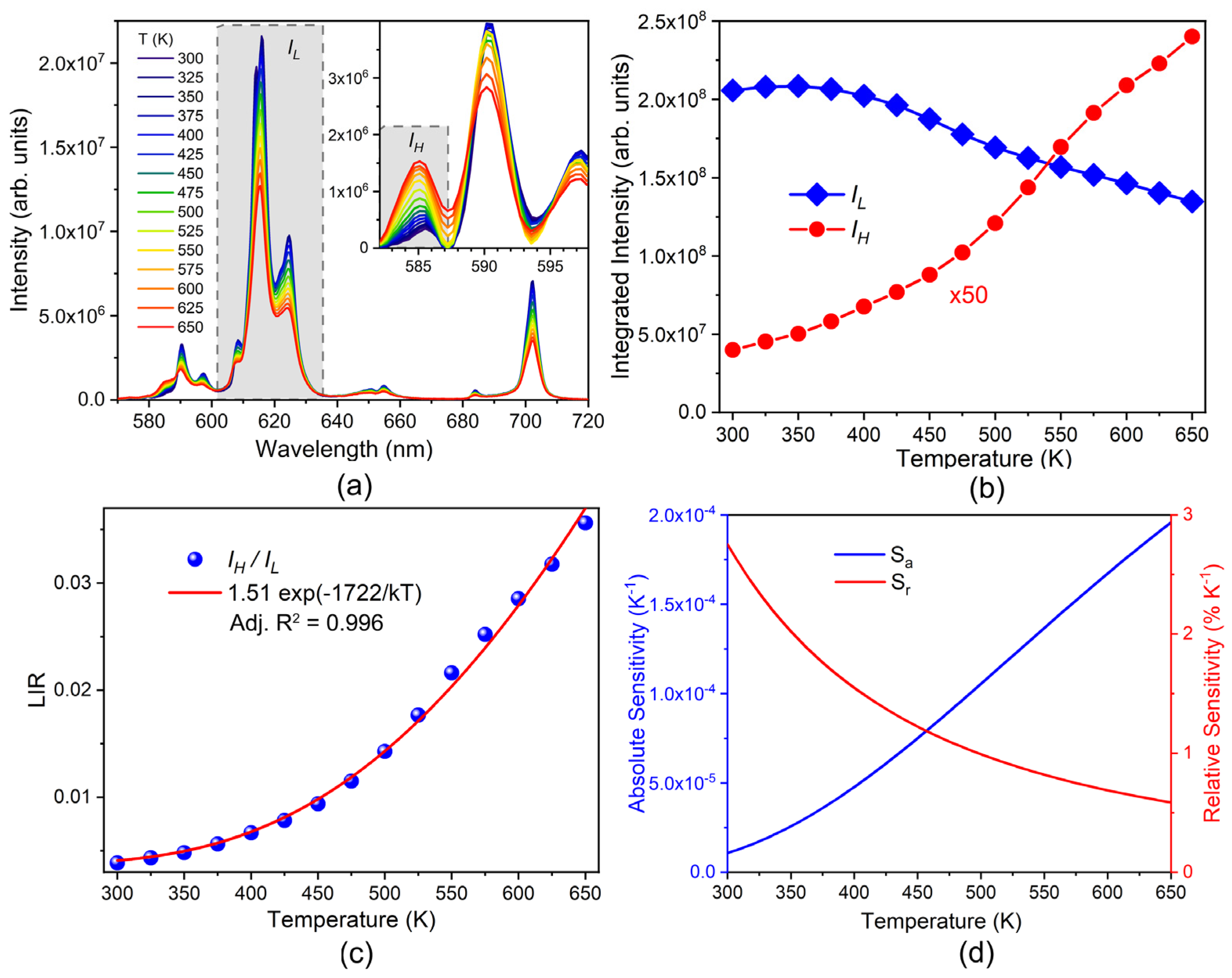
4. Conclusions
- Incorporation of Eu3+ ions affects the crystal structure of Y2Mo3O12; the existence of an orthorhombic via tetragonal to monoclinic phase transition, depending on the concentration of dopant Eu3+ ions is shown.
- The luminescence intensity of Eu3+-doped Y2Mo3O12 samples was enhanced by increasing the Eu3+ dopant concentration up to optimum 80 mol% of Eu3+.
- Emission intensity shows high-temperature stability in the maximal operating temperature of LEDs and the YMO80Eu sample remains at 98% of its initial value at 100 °C.
- An optimized 80 mol% Eu3+-doped Y2Mo3O12 sample is proposed as a promising thermal probe with a relative sensitivity of 2.8% K−1 at room temperature.
- The peak sharpening method is equally effective as the peak deconvolution method in the separation of overlapping peaks for the luminescence intensity ratio method.
Supplementary Materials
Author Contributions
Funding
Institutional Review Board Statement
Informed Consent Statement
Data Availability Statement
Conflicts of Interest
References
- Dramićanin, M. Luminescence Thermometry: Methods, Materials, and Applications; Woodhead publishing series in electronic and optical materials; Woodhead Publishing: Duxford, UK; Cambridge, MA, USA, 2018; ISBN 978-0-08-102029-6. [Google Scholar]
- Laufer, S.; Strobel, S.; Schleid, T.; Cybinska, J.; Mudring, A.-V.; Hartenbach, I. Yttrium(III) Oxomolybdates(VI) as Potential Host Materials for Luminescence Applications: An Investigation of Eu3+-Doped Y2[MoO4]3 and Y2[MoO4]2[Mo2O7]. New J. Chem. 2013, 37, 1919. [Google Scholar] [CrossRef]
- Wang, S.; Koteswara Rao, K.; Wang, Y.; Hsu, Y.; Chen, S.; Lu, Y. Structural Characterization and Luminescent Properties of a Red Phosphor Series: Y2−x Eux(MoO4)3 (X = 0.4–2.0). J. Am. Ceram. Soc. 2009, 92, 1732–1738. [Google Scholar] [CrossRef]
- Huang, Q.; Xu, J.; Li, W. Preparation of Tetragonal Defect Scheelite-Type RE2(MoO4)3 (RE=La TO Ho) by Precipitation Method. Solid State Ion. 1989, 32–33, 244–249. [Google Scholar] [CrossRef]
- Marinkovic, B.A.; Jardim, P.M.; De Avillez, R.R.; Rizzo, F. Negative Thermal Expansion in Y2Mo3O12. Solid State Sci. 2005, 7, 1377–1383. [Google Scholar] [CrossRef]
- Nassau, K.; Levinstein, H.J.; Loiacono, G.M. A Comprehensive Study of Trivalent Tungstates and Molybdates of the Type L2(MO4)3. J. Phys. Chem. Solids 1965, 26, 1805–1816. [Google Scholar] [CrossRef]
- Nassau, K.; Shiever, J.W.; Keve, E.T. Structural and Phase Relationships among Trivalent Tungstates and Molybdates. J. Solid State Chem. 1971, 3, 411–419. [Google Scholar] [CrossRef]
- Dmitriev, V.; Sinitsyn, V.; Dilanian, R.; Machon, D.; Kuznetsov, A.; Ponyatovsky, E.; Lucazeau, G.; Weber, H.P. In Situ Pressure-Induced Solid-State Amorphization in Sm2(MoO4)3, Eu2(MoO4)3 and Gd2(MoO4)3 Crystals: Chemical Decomposition Scenario. J. Phys. Chem. Solids 2003, 64, 307–312. [Google Scholar] [CrossRef]
- Lucazeau, G.; Bouvier, P.; Pasturel, A.; Le Bacq, O.; Pagnier, T. High-Pressure Study of Gd2(MoO4)3 by Raman Scattering and Ab Initio Calculations. Acta Phys. Pol. A 2009, 116, 25–31. [Google Scholar] [CrossRef]
- Young, L.; Gadient, J.; Lind, C. High Pressure Behavior of Chromium and Yttrium Molybdate (Cr2Mo3O12, Y2Mo3O12). Front. Chem. 2018, 6, 478. [Google Scholar] [CrossRef]
- Gates, S.D.; Lind, C. Polymorphism in Yttrium Molybdate Y2Mo3O12. J. Solid State Chem. 2007, 180, 3510–3514. [Google Scholar] [CrossRef]
- Zhang, X.; Wu, J.; Wang, P.; Gao, J.; Gao, F.; Gao, D. Enhancing the static green up-conversion luminescence of NaY(MoO4)2:Yb/Er microcrystals via an annealing strategy for anti-counterfeiting applications. Dalton Trans. 2021, 50, 7826–7834. [Google Scholar] [CrossRef]
- Atuchin, V.V.; Aleksandrovsky, A.S.; Chimitova, O.D.; Gavrilova, T.A.; Krylov, A.S.; Molokeev, M.S.; Oreshonkov, A.S.; Bazarov, B.G.; Bazarova, J.G. Synthesis and Spectroscopic Properties of Monoclinic α-Eu2(MoO4)3. J. Phys. Chem. C 2014, 118, 15404–15411. [Google Scholar] [CrossRef]
- Gou, H.; Wu, Q.; Luo, L.; Li, W.; Du, P. Reengineering the Thermometric Behaviors of Er3+/Yb3+-Codoped Gd2Mo3O12 Microparticles via Dual-Mode Luminescence Manipulation. Ceram. Int. 2023, 49, 38297–38304. [Google Scholar] [CrossRef]
- Zou, H.; Chen, B.; Hu, Y.; Zhang, Q.; Wang, X.; Wang, F. Simultaneous Enhancement and Modulation of Upconversion by Thermal Stimulation in Sc2Mo3O12 Crystals. J. Phys. Chem. Lett. 2020, 11, 3020–3024. [Google Scholar] [CrossRef]
- Liu, W.; Xu, S.; Lei, L. Enhancing Upconversion of Sc2Mo3O12:Yb/Ln (Ln = Er, Ho) Phosphors by Doping Ca2+ Ions. Opt. Mater. 2023, 143, 114166. [Google Scholar] [CrossRef]
- Liao, J.; Wang, M.; Lin, F.; Han, Z.; Fu, B.; Tu, D.; Chen, X.; Qiu, B.; Wen, H.-R. Thermally Boosted Upconversion and Downshifting Luminescence in Sc2(MoO4)3:Yb/Er with Two-Dimensional Negative Thermal Expansion. Nat. Commun. 2022, 13, 2090. [Google Scholar] [CrossRef]
- Du, P.; Luo, L.; Hou, Y.; Li, W. Energy Transfer-Triggered Multicolor Emissions in Tb3+/Eu3+-Coactivated Y2Mo3O12 Negative Thermal Expansion Microparticles for Dual-Channel Tunable Luminescent Thermometers. Mater. Adv. 2021, 2, 4824–4831. [Google Scholar] [CrossRef]
- Kumari, A.; Mukhopadhyay, L.; Rai, V.K. Er3+/Yb3+/Li+/Zn2+: Gd2(MoO4)3 Upconverting Nanophosphors in Optical Thermometry. J. Rare Earths 2019, 37, 242–247. [Google Scholar] [CrossRef]
- Lv, H.; Du, P.; Luo, L.; Li, W. Negative Thermal Expansion Triggered Anomalous Thermal Upconversion Luminescence Behaviors in Er3+/Yb3+-Codoped Y2Mo3O12 Microparticles for Highly Sensitive Thermometry. Mater. Adv. 2021, 2, 2642–2648. [Google Scholar] [CrossRef]
- Yang, Y.; Lin, L.; Lu, P.; Feng, Z.; Li, Z.; Cai, J.; Mei, Z.; Huang, Y.; Guo, W.; Wang, Z.; et al. A Linear Calibrated High Temperature Sensor Based on Up-Conversion Fluorescence of Y2Mo3O12:Er3+, Yb3+ Enhanced by Negative Thermal Expansion. J. Lumin. 2021, 240, 118410. [Google Scholar] [CrossRef]
- Ćirić, A.; Ristić, Z.; Antić, Ž.; Dramićanin, M.D. An Approximate Deconvolution Method for the Luminescence Intensity Ratio Calculations from Overlapping Emissions. Phys. B Condens. Matter 2022, 624, 413454. [Google Scholar] [CrossRef]
- Dang, P.; Li, G.; Yun, X.; Zhang, Q.; Liu, D.; Lian, H.; Shang, M.; Lin, J. Thermally Stable and Highly Efficient Red-Emitting Eu3+-Doped Cs3GdGe3O9 Phosphors for WLEDs: Non-Concentration Quenching and Negative Thermal Expansion. Light: Sci. Appl. 2021, 10, 29. [Google Scholar] [CrossRef] [PubMed]
- Ga, D.; Zhang, X.; Zhang, J. The effects of structural characterization on the luminescence of Eu3+-doped fluoride nano/microcrystals. CrystEngComm 2014, 16, 11115–11121. [Google Scholar] [CrossRef]
- OSRAM. LB QH9G Chip LED 0402 Datasheet n.d. Available online: https://look.ams-osram.com/m/3184c82bafe7f3ef/original/lb-qh9g.pdf (accessed on 20 March 2024).
- XLamp. XLAMP® WHITE LEDs n.d. Available online: https://downloads.cree-led.com/files/fs/XLamp-Discrete-Directional-Feature-Sheet.pdf (accessed on 20 March 2024).
- Dejneka, M.; Snitzer, E.; Riman, R.E. Blue, Green and Red Fluorescence and Energy Transfer of Eu3+ in Fluoride Glasses. J. Lumin. 1995, 65, 227–245. [Google Scholar] [CrossRef]
- Anderssen, R.S.; Hegland, M. Derivative Spectroscopy An Enhanced Role for Numerical Differentiation. J. Integral Equ. Appl. 2010, 22, 355–367. [Google Scholar] [CrossRef]
- Hegland, M.; Anderssen, R.S. Resolution Enhancement of Spectra Using Differentiation. Inverse Probl. 2005, 21, 915–934. [Google Scholar] [CrossRef]
- Wade, S.A.; Collins, S.F.; Baxter, G.W. Fluorescence Intensity Ratio Technique for Optical Fiber Point Temperature Sensing. J. Appl. Phys. 2003, 94, 4743–4756. [Google Scholar] [CrossRef]
- Carnall, W.T.; Crosswhite, H.; Crosswhite, H.M. Energy Level Structure and Transition Probabilities in the Spectra of the Trivalent Lanthanides in LaF3; Argonne National Lab. (ANL): Argonne, IL, USA, 1978; ANL-78-XX-95, 6417825. [Google Scholar]
- Suta, M. Performance of Boltzmann and Crossover Single-Emitter Luminescent Thermometers and Their Recommended Operation Modes. Opt. Mater. X 2022, 16, 100195. [Google Scholar] [CrossRef]
- Tian, Y.; Tian, B.; Cui, C.; Huang, P.; Wang, L.; Chen, B. Excellent Optical Thermometry Based on Single-Color Fluorescence in Spherical NaEuF4 Phosphor. Opt. Lett. 2014, 39, 4164. [Google Scholar] [CrossRef]
- Ćirić, A.; Stojadinović, S.; Dramićanin, M.D. Time-Integrated Luminescence Thermometry of Eu3+ and Dy3+ Doped YVO4. Sens. Actuators A Phys. 2019, 295, 450–455. [Google Scholar] [CrossRef]
- Bu, Y.; Yan, X. Temperature Dependent Photoluminescence of Eu3+-Doped Ca7V4O17. J. Lumin. 2017, 190, 50–55. [Google Scholar] [CrossRef]
- Senapati, S.; Nanda, K.K. Red Emitting Eu:ZnO Nanorods for Highly Sensitive Fluorescence Intensity Ratio Based Optical Thermometry. J. Mater. Chem. C 2017, 5, 1074–1082. [Google Scholar] [CrossRef]
- Liang, Z.; Qin, F.; Zheng, Y.; Zhang, Z.; Cao, W. Noncontact Thermometry Based on Downconversion Luminescence from Eu3+ Doped LiNbO3 Single Crystal. Sens. Actuators A Phys. 2016, 238, 215–219. [Google Scholar] [CrossRef]
- Ćirić, A.; Marciniak, Ł.; Dramićanin, M.D. Luminescence Intensity Ratio Squared—A New Luminescence Thermometry Method for Enhanced Sensitivity. J. Appl. Phys. 2022, 131, 114501. [Google Scholar] [CrossRef]
- Ćirić, A.; Stojadinović, S.; Dramićanin, M.D. Luminescence Intensity Ratio Thermometry and Judd-Ofelt Analysis of TiO2:Eu3+. Opt. Mater. 2018, 85, 261–266. [Google Scholar] [CrossRef]
- Das, S.; Som, S.; Yang, C.-Y.; Chavhan, S.; Lu, C.-H. Structural Evaluations and Temperature Dependent Photoluminescence Characterizations of Eu3+-Activated SrZrO3 Hollow Spheres for Luminescence Thermometry Applications. Sci. Rep. 2016, 6, 25787. [Google Scholar] [CrossRef]
- Ćirić, A.; Dramićanin, M.D. LumTHools—Software for Fitting the Temperature Dependence of Luminescence Emission Intensity, Lifetime, Bandshift, and Bandwidth and Luminescence Thermometry and Review of the Theoretical Models. J. Lumin. 2022, 252, 119413. [Google Scholar] [CrossRef]
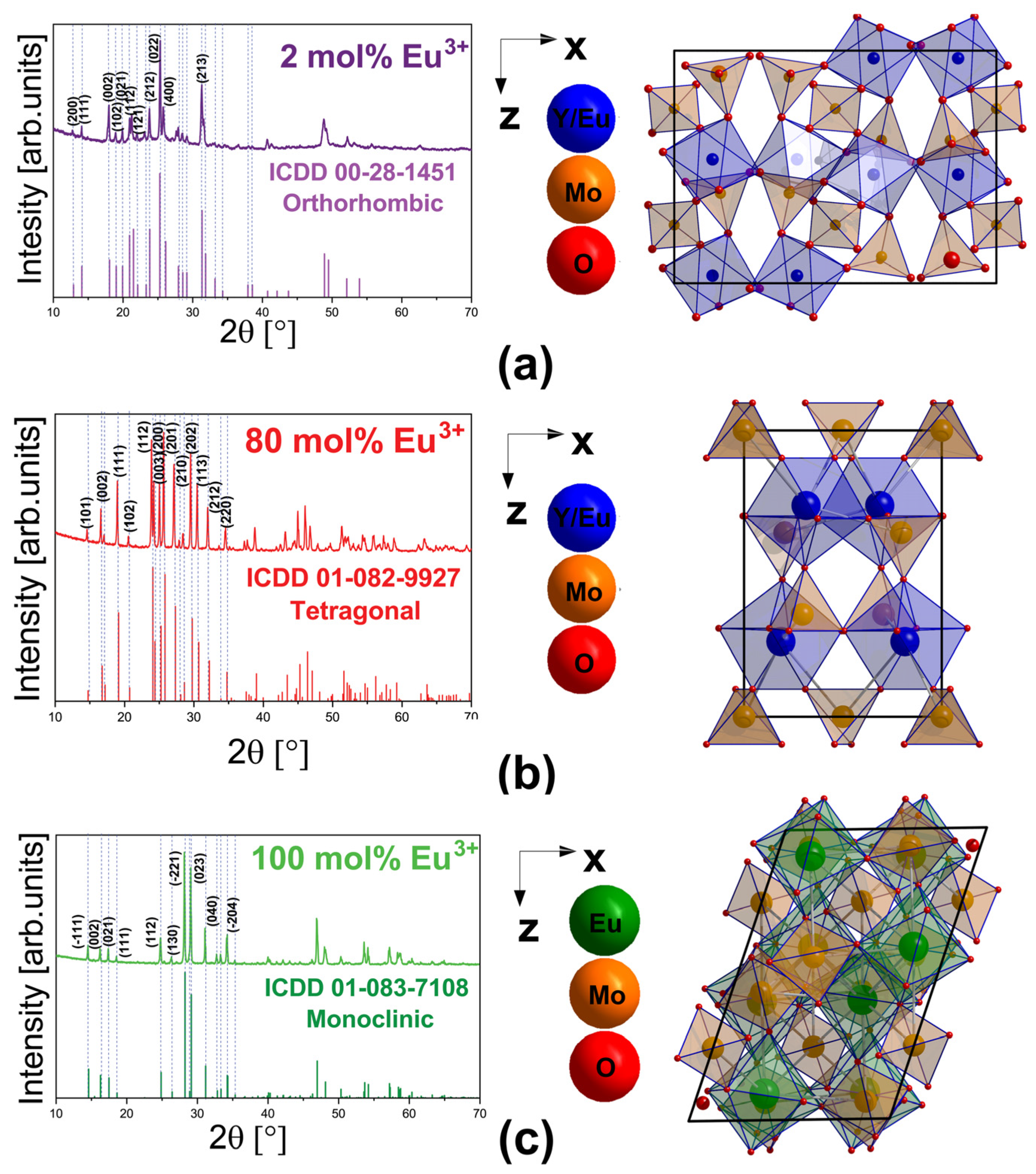
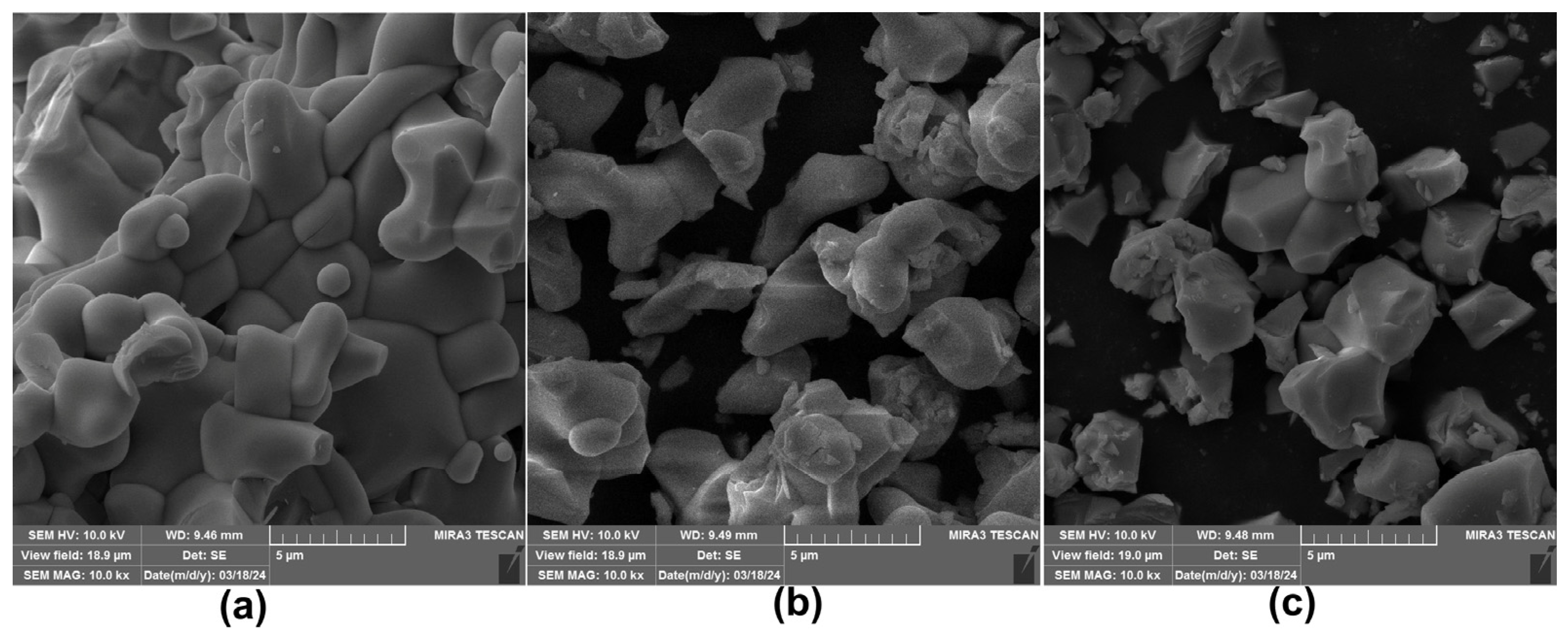
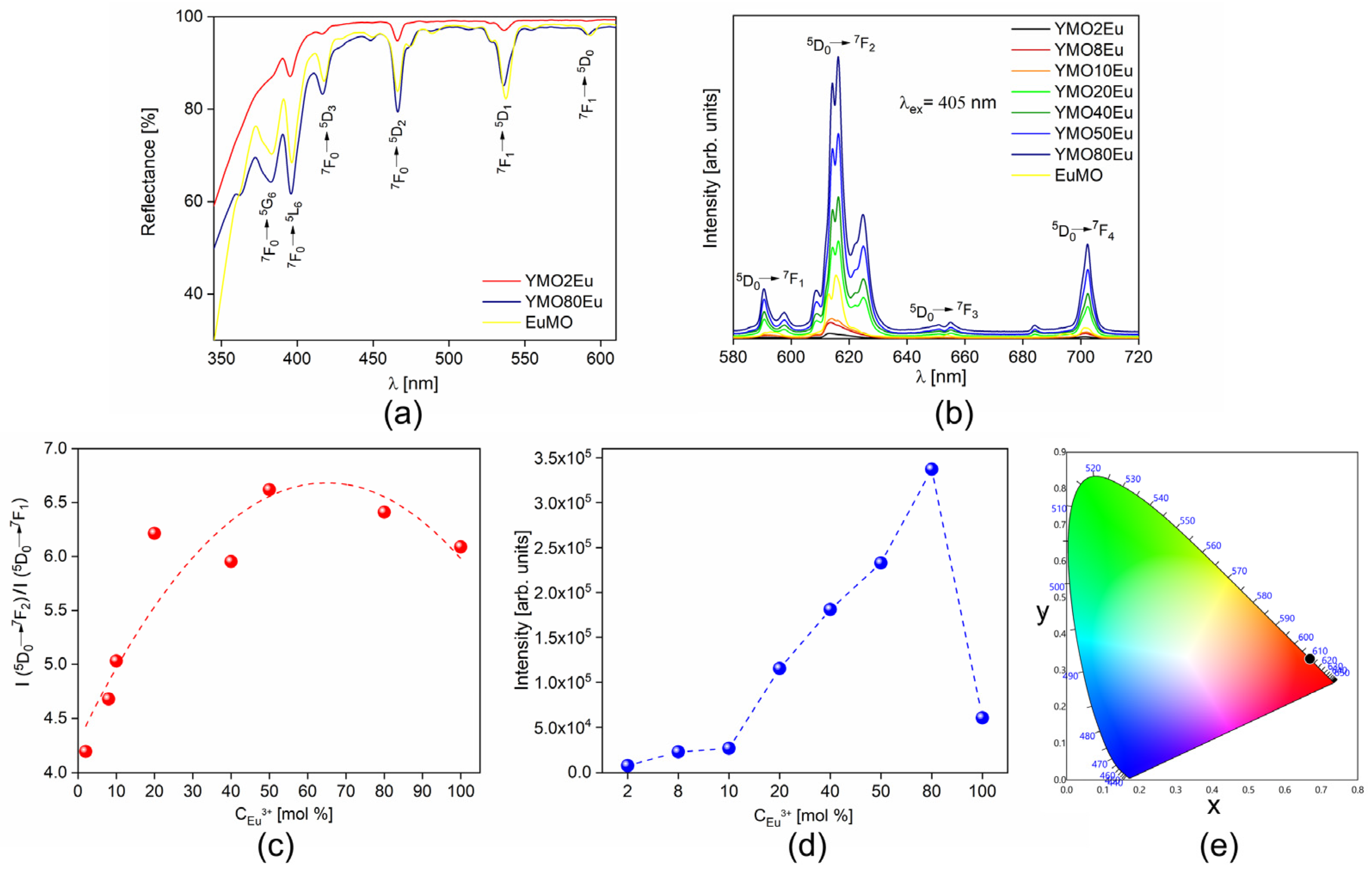
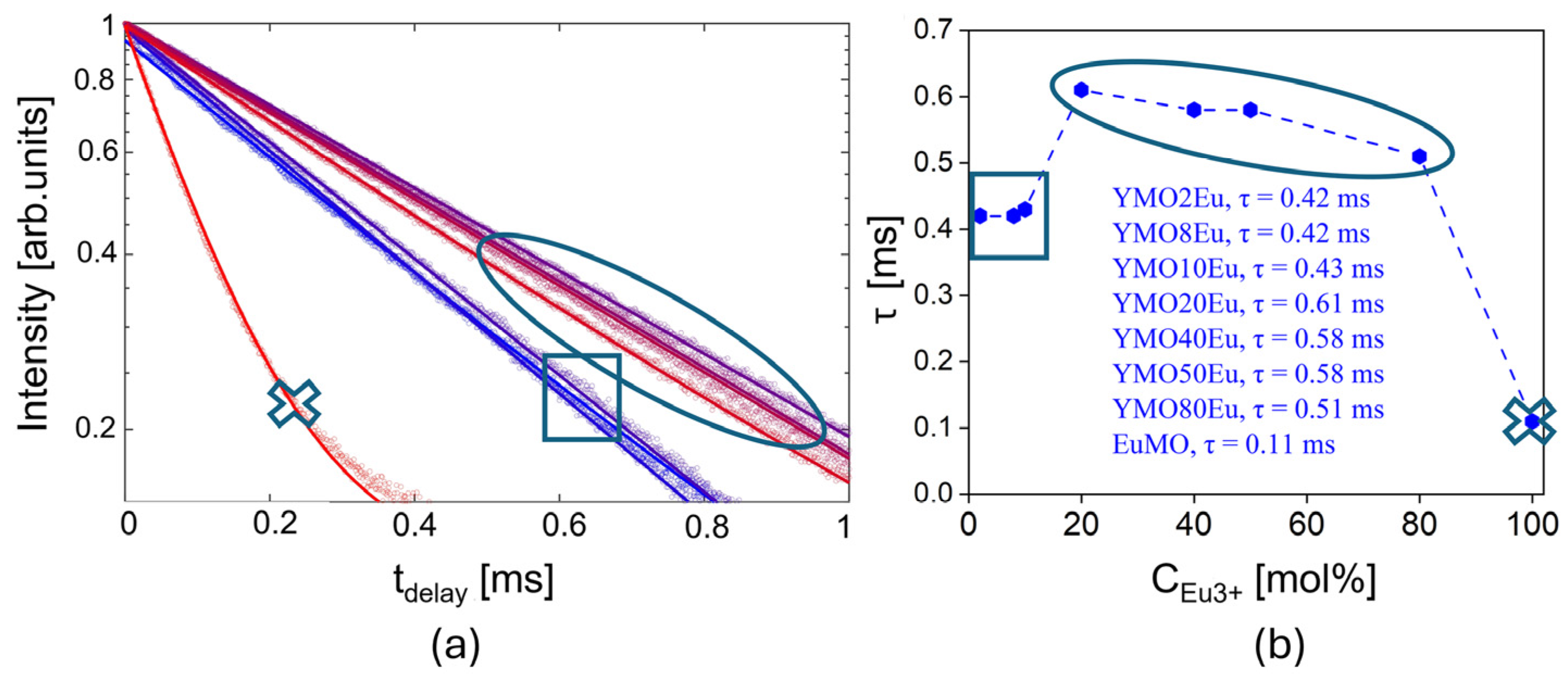
| Eu3+ Concentration (mol %) | Sample Formula Y2−xEuxMo3O12 | Abbreviated Sample Name |
|---|---|---|
| 2 | Y1.96Eu0.04Mo3O12 | YMO2Eu |
| 8 | Y1.84Eu0.16Mo3O12 | YMO8Eu |
| 10 | Y1.8Eu0.2Mo3O12 | YMO10Eu |
| 20 | Y1.6Eu0.4Mo3O12 | YMO20Eu |
| 40 | Y1.2Eu0.8Mo3O12 | YMO40Eu |
| 50 | Y1Eu1Mo3O12 | YMO50Eu |
| 80 | Y0.4Eu1.6Mo3O12 | YMO80Eu |
| 100 | Eu2Mo3O12 | EuMO |
| Sample | YMO2Eu | YMO8Eu | YMO40Eu | YMO50Eu | YMO80Eu | EuMO |
|---|---|---|---|---|---|---|
| orthorhombic | orthorhombic | tetragonal | tetragonal | tetragonal | monoclinic | |
| No. | 01-075-5430 | 01-075-5430 | 01-082-9927 | 01-082-9927 | 01-082-9927 | 01-083-7108 |
| Rwp (%) | 12.43 | 10.21 | 6.14 | 7.35 | 5.67 | 7.85 |
| Rp (%) | 8.16 | 6.77 | 4.62 | 5.29 | 4.29 | 5.06 |
| Re (%) | 3.17 | 3.23 | 3.04 | 3.26 | 3.35 | 2.78 |
| GOF | 3.9263 | 3.1638 | 2.0181 | 2.2523 | 1.6941 | 2.8204 |
| CS (Å) | 165(5) | 288(50) | 455(12) | 366(9) | 299(8) | 418(9) |
| Strain | 0.13(2) | 0.83(19) | 0.0660 | 0.12(17) | 0.13(6) | 0.11(5) |
| a | 13.755(2) | 13.7340(14) | 7.3230(4) | 7.3357(2) | 7.3625(9) | 7.591(3) |
| b | 9.909(3) | 9.9237(14) | 7.3230(4) | 7.3357(2) | 7.3625(9) | 11.4651(5) |
| c | 9.906(2) | 9.9370(11) | 10.6292(6) | 10.6551(4) | 10.6979(9) | 11.5021(5) |
Disclaimer/Publisher’s Note: The statements, opinions and data contained in all publications are solely those of the individual author(s) and contributor(s) and not of MDPI and/or the editor(s). MDPI and/or the editor(s) disclaim responsibility for any injury to people or property resulting from any ideas, methods, instructions or products referred to in the content. |
© 2024 by the authors. Licensee MDPI, Basel, Switzerland. This article is an open access article distributed under the terms and conditions of the Creative Commons Attribution (CC BY) license (https://creativecommons.org/licenses/by/4.0/).
Share and Cite
Gavrilović, T.; Ćirić, A.; Medić, M.; Ristić, Z.; Periša, J.; Antić, Ž.; Dramićanin, M.D. Structure–Dopant Concentration Relations in Europium-Doped Yttrium Molybdate and Peak-Sharpening for Luminescence Temperature Sensing. Materials 2024, 17, 4267. https://doi.org/10.3390/ma17174267
Gavrilović T, Ćirić A, Medić M, Ristić Z, Periša J, Antić Ž, Dramićanin MD. Structure–Dopant Concentration Relations in Europium-Doped Yttrium Molybdate and Peak-Sharpening for Luminescence Temperature Sensing. Materials. 2024; 17(17):4267. https://doi.org/10.3390/ma17174267
Chicago/Turabian StyleGavrilović, Tamara, Aleksandar Ćirić, Mina Medić, Zoran Ristić, Jovana Periša, Željka Antić, and Miroslav D. Dramićanin. 2024. "Structure–Dopant Concentration Relations in Europium-Doped Yttrium Molybdate and Peak-Sharpening for Luminescence Temperature Sensing" Materials 17, no. 17: 4267. https://doi.org/10.3390/ma17174267
APA StyleGavrilović, T., Ćirić, A., Medić, M., Ristić, Z., Periša, J., Antić, Ž., & Dramićanin, M. D. (2024). Structure–Dopant Concentration Relations in Europium-Doped Yttrium Molybdate and Peak-Sharpening for Luminescence Temperature Sensing. Materials, 17(17), 4267. https://doi.org/10.3390/ma17174267









